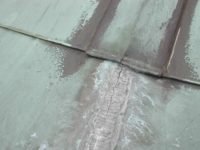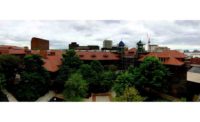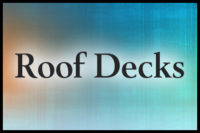Zinc roofing has been extensively used in Europe for over two centuries, and was introduced into the U.S. market in the 1990s. Zinc is a naturally weathering material that many building designers admire due to its rich coloring and matte finish. However, zinc is prone to premature corrosion when the backside is exposed to repeated contact with water in the absence of air. Manufacturers and architects have used various methods to prevent water from causing accelerated backside corrosion of zinc products. It is relatively frequent practice to provide a ventilation space beneath zinc panels to allow airflow beneath the zinc panels to promote drying. Over the years, we have seen multiple zinc roof failures associated with backside corrosion due to material selection, and improper flashing and ventilation detailing. This article will provide a comprehensive explanation of the zinc corrosion mechanism, and will discuss the nuances of properly designing zinc roofs and cladding to minimize leakage and the risk of backside corrosion.
Zinc roofing has been used extensively in Europe for over two centuries and, more recently, has gained popularity in the U.S. Zinc is a naturally weathering material that many building designers admire due to its rich blue-gray coloring, matte finish and natural appearance (Photo 1). Architectural-grade zinc is malleable, relatively strong and can be field-soldered, lending itself to use in irregular architectural profiles. The material is also versatile, and can be used as both roofing and cladding allowing for smooth transitions between the assemblies, where desired.
Zinc roofing and cladding is marketed for its low-life cycle costs relative to other sheet metal products. Material costs for sheet metal zinc are similar to copper, aluminum, and stainless steel. The service life of zinc roofing is generally estimated at 70 years; however, some buildings in Europe have portions of original zinc roofing performing well up to 120 years after installation. While in service, zinc panels require minimal maintenance due to the natural formation of a protective patina when exposed to the atmosphere. While some metals may require recoating over time, if zinc panels are scratched new patina will form on the exposed freshly exposed zinc. At the end of service, virtually all the zinc material can be recycled and recovered for use in galvanizing. While architectural-grade zinc has many properties that make it a natural choice for use on building enclosures, the material is susceptible to premature corrosion if not designed and installed properly.
Bring on the Water
The same process that allows for the formation of the protective patina on the surface of exposed zinc can be detrimental under specific conditions. Near-pure zinc exposed to the atmosphere will react with oxygen to produce a thin layer of zinc oxide. When the zinc oxide layer is exposed to moisture, it forms zinc hydroxide. When the moisture is dried from the surface of the metal, the zinc hydroxide reacts with carbon dioxide in the atmosphere to form zinc hydroxyl carbonate. After repeated wetting and drying cycles, a durable, well-bonded zinc hydroxyl carbonate layer is typically formed on the surface of the metal. Zinc hydroxyl carbonate is a stable material that does not react in the presence of water and functions as a protective patina layer to control the corrosion rate of the exposed zinc.
In the continued presence of water and the absence of air, such as on the backside of zinc roofing or cladding panels where water infiltration occurs, zinc hydroxide can form, but sufficient carbon dioxide is not present to convert the corrosion products into the protective zinc hydroxyl carbonate. Zinc oxide and zinc hydroxide are not stable or well-bonded to the surface of the zinc and are porous; therefore, they offer no protection to the base metal. With continued exposure to moisture, water continues to react with the zinc oxide forming additional zinc hydroxide and consuming additional zinc in the process. The zinc hydroxide layer becomes thicker, forming a build-up of white corrosion product commonly referred to as “white rust.” The reaction can continue unabated until eventually the entire thickness of the metal can be consumed by corrosion.
The Fight Against Leaks
Although architectural metal roofs are designed to prevent bulk water leakage, they are considered “water-shedding” roof systems, and it is anticipated that small amounts of water may bypass the panels at certain detail conditions. For this reason, metal panel roofs have historically been designed with continuous roofing underlayment to collect and drain incidental leakage water from the system. Most metal roofing materials can tolerate minor water leakage through metal roofing detail conditions without shortening the service life of the roofing material. However, zinc products do not tolerate minor roof leakage or condensation without allowing corrosion that can eventually lead to failure of the roofing material. This process of zinc corrosion on the backside of metal roofing panels has been well documented in the industry for many years. The same corrosion process occurs on galvanized steel (steel coated with nearly pure zinc coating), and occurrences of “wet storage stain”, and its prevention, have been well documented in the industry for decades.
Since the major introduction of zinc roofing, manufacturers have used various methods to control accelerated backside corrosion of zinc products. Common methods to prevent backside corrosion include: providing a “ventilation” space beneath the roofing, using three-dimensional polymer separation mats for venting, and applying organic coatings to the backside of the zinc sheets, resulting in variable degrees of success.
Several variations of separation mats have been used over the years in zinc roofing installations in an attempt to “ventilate” beneath the zinc panel. Typically, these products are either dimpled composite sheets or woven polymer sheets, and range in thickness from 1/8- to 1/2-inch. A critical design consideration when using a separation mat is how the system is detailed at anchor clips and eaves. Typically either the separation sheets are cut out around or extend continuously under the clips. In either condition, when the panels are installed the separation sheets are compressed, commonly resulting in the zinc panel in intimate contact with the substrate thereby defeating the purpose of the separation mat in localized areas (Photo 2). Additionally, it is common for the separation mats to be discontinuous at the roof edge resulting in another condition where the zinc panel is at risk for contact with water.
The Issue of Backside Corrosion
Some zinc manufacturers apply a coating on the backside to protect the zinc from backside corrosion in the event of minor roof leakage or condensation. The coating is typically a factory-applied organic paint that that varies in thickness between manufacturers. The coating is applied in an attempt to prevent moisture from wetting the zinc. However, the authors have observed that this coating is not effective in preventing corrosion, where moisture caused deterioration of the coating and then the zinc in a manner consistent with typical backside corrosion of uncoated zinc. Typical incidental leakage associated with metal roofing detailing flowed down the roof slope, between the roofing panels and the roofing underlayment, and was in contact with the zinc in many areas. Where leakage water contacted the zinc, it caused varying degrees of corrosion on the backside of the zinc roofing panels. The corrosion ranged from initial signs of backside coating deterioration and zinc corrosion (white rust), to complete corrosion through the thickness of the zinc panels (Photos 3-6).
The only proven method to protect the zinc panels from contact with water infiltration or condensation is to provide an airspace, or capillary break, between the backside of the zinc and underlayment, by using furring to lift the panels off of the underlayment. Alternating furring, installed parallel and then perpendicular to the roof slope, provides both an airspace and drainage plane within the roof assembly to prevent any water infiltration from contacting the zinc. Water infiltration that bypasses the roof panels can drop down onto an underlayment, and with proper detailing, drain down the roof slope and out through the eave. Including an airspace within this type of roofing assembly adds cost due to additional labor and materials, potentially making a zinc roofing system more expensive than other metal roofing material choices that are not susceptible to backside corrosion, such as copper or tin-zinc coated copper.
Providing an airspace below zinc roofing is commonly referred to as “ventilation,” which indicates a certain volume of air flow through the space. However, based on the authors’ experience it is more critical to raise the zinc off of the substrate to prevent contact between the zinc and any incidental water leakage, rather than provide a certain amount of ventilation air exchanges within the space. Misconceptions persist regarding the intent of the ventilation system and how it functions. Many sloped roofs use a “cold roof” design, in which a ventilation pathway is provided from the eave to the ridge above the plane of insulation. Stack pressure draws air from the bottom of the roof eave up the roof slope and out of the ridge vent, allowing the airspace below the roof cladding to reach temperatures similar to the outdoor temperature. During winter months in cold climates, this helps prevent ice-dam formation as heat loss from the interior is mitigated by the cold air drawn from the exterior. Typically this type of ventilation space is installed beneath the roof sheathing; however, this location will not protect a zinc roof from potential backside corrosion because the zinc may still be in direct contact with the underlayment and subject to wetting from to incidental roof leaks. The authors have observed zinc corrosion on roofs with ventilation below the sheathing.
Conclusion
The detailing of zinc roofing systems is critical to limit the risk of incidental leakage behind the roofing, to avoid exposure of the panel to direct contact with water. Special attention should be given to detailing at panel closures, ridges, hips and rising walls. Panel closures at ridges and hips should not be cut to form turned-up pans, as this results in reliance on sealant to protect against leakage. Instead, panel closures should be fabricated using a “bread-pan” technique which folds the panel in a manner to create a pan without cutting the panel (Photo 6). Ridge details should include a continuous cleat at the upturned panels, and a Z-shaped closure between the panels seams. The Z-closure should be soldered continuously between the panel seams.
Even with appropriate detailing, a zinc roof design should always mimic, to some degree, a rainscreen cladding installation. The zinc panels should always have an airspace directly below, and should not be in direct contact with the underlayment or other materials to ensure that incidental water infiltration or condensation will not come in contact with the panel, resulting in premature failure of the zinc panels.














